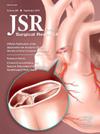Selecting Treatments for Peripheral Artery Disease: Differences Between Registry and a Randomized Controlled Trial Population
IF 1.8
3区 医学
Q2 SURGERY
引用次数: 0
Abstract
Introduction
Patients enrolled in randomized trials are carefully selected and may have different comorbidities than patients treated in everyday practice.
Methods
We compared characteristics of 1815 patients enrolled in the Best Endovascular or Surgical Treatment for Critical Limb Ischemia (BEST-CLI, NCT02060630) with 104,877 patients receiving endovascular treatment and 32,120 patients undergoing bypass in the Vascular Quality Initiative's (VQI) registry from 2014 to 2020 using descriptive statistics. We studied mortality by treatment type among patients in both the trial and registry using Cox regression. We adjusted for differences in patient characteristics using inverse probability weighting with propensity scores.
Results
Compared to the BEST-CLI participants, patients in the VQI registry were commonly older, female, and of non-Hispanic ethnicity. Chronic obstructive pulmonary disease and congestive heart failure were more prevalent in VQI, while coronary artery disease and diabetes rates were higher in BEST-CLI. The unadjusted 1-y mortality in VQI was 12.5% following endovascular treatment and 10.2% following bypass. After weighting VQI patients to represent the BEST-CLI sample, the cumulative 5-y mortality was higher in those undergoing endovascular treatment versus bypass (26.3% versus 23.7%, P < 0.001). Bypass was associated with an 8% lower mortality than endovascular treatment (hazard ratio = 0.92, 95% CI:0.87-0.98, P = 0.005). This effect remained across all weighting schemes, even when limiting to patients treated at a BEST-CLI site.
Conclusions
Patients enrolled in BEST-CLI differ from patients treated in VQI. However, reweighting VQI data to represent BEST-CLI yields similar estimates of treatment effects in VQI data, supporting a role for registry-based analytic models in answering comparative, real-world clinical questions.
求助全文
约1分钟内获得全文
求助全文
来源期刊
CiteScore
3.90
自引率
4.50%
发文量
627
审稿时长
138 days
期刊介绍:
The Journal of Surgical Research: Clinical and Laboratory Investigation publishes original articles concerned with clinical and laboratory investigations relevant to surgical practice and teaching. The journal emphasizes reports of clinical investigations or fundamental research bearing directly on surgical management that will be of general interest to a broad range of surgeons and surgical researchers. The articles presented need not have been the products of surgeons or of surgical laboratories.
The Journal of Surgical Research also features review articles and special articles relating to educational, research, or social issues of interest to the academic surgical community.

 求助内容:
求助内容: 应助结果提醒方式:
应助结果提醒方式:


